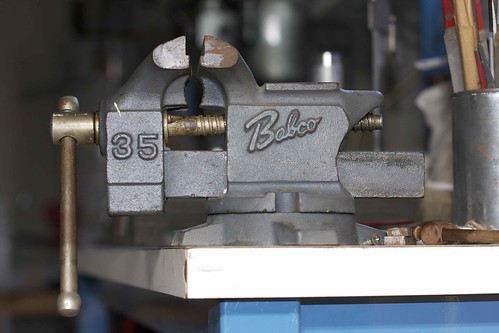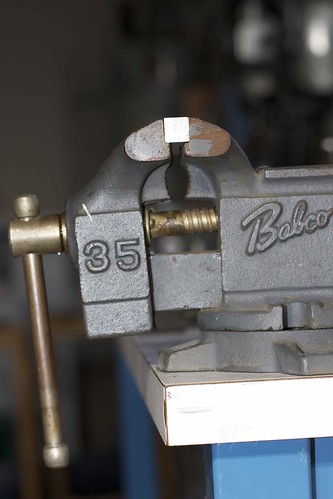- Joined
- Oct 29, 2011
- Messages
- 287
- Reaction score
- 2
I picked up this Babco bench vise for $15 at an estate sale:

but after getting it home and taking a closer look, I find that the outer jaw is loose on the shaft (not sure what this part is called; the lower bar that slides in the base), so when I tighten it up, the jaw pivots and and the jaws no longer mate nicely:

I can't figure out how the shaft is held in the outer jaw; there are no pins that I can see, so I can only assume that the jaw was cast round the shaft.
I'm pondering whether it's worth fixing this, and if so, how.
I could drill through the outer jaw and shaft (just under the '5' of 35 on the casting) and put in a pin or two. If I did that, would the pin(s) hold out? If I used drill rod for the pin, should I harden it? There's a lot of force when tightening down the vise, so the pins might just get chewed up.
The other alternative is to live with the flex, and just make some new jaws (I was thinking of using Al, since I want soft jaws most of the time) that take the angles into account. I could tighten the vise down on the jaw parts, then mill a slot, then remove some material to make mating jaws.
Thoughts?
Simon

but after getting it home and taking a closer look, I find that the outer jaw is loose on the shaft (not sure what this part is called; the lower bar that slides in the base), so when I tighten it up, the jaw pivots and and the jaws no longer mate nicely:

I can't figure out how the shaft is held in the outer jaw; there are no pins that I can see, so I can only assume that the jaw was cast round the shaft.
I'm pondering whether it's worth fixing this, and if so, how.
I could drill through the outer jaw and shaft (just under the '5' of 35 on the casting) and put in a pin or two. If I did that, would the pin(s) hold out? If I used drill rod for the pin, should I harden it? There's a lot of force when tightening down the vise, so the pins might just get chewed up.
The other alternative is to live with the flex, and just make some new jaws (I was thinking of using Al, since I want soft jaws most of the time) that take the angles into account. I could tighten the vise down on the jaw parts, then mill a slot, then remove some material to make mating jaws.
Thoughts?
Simon







